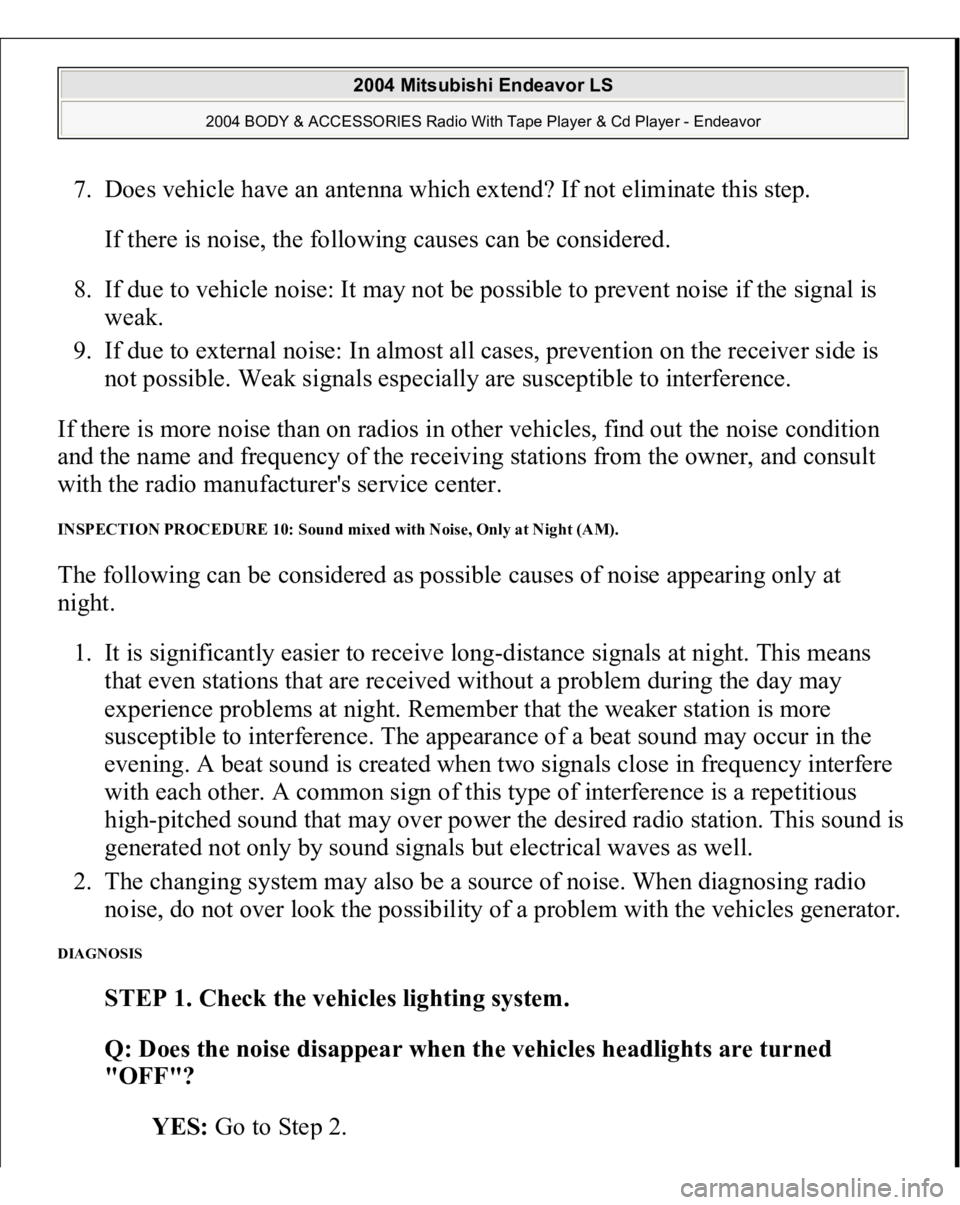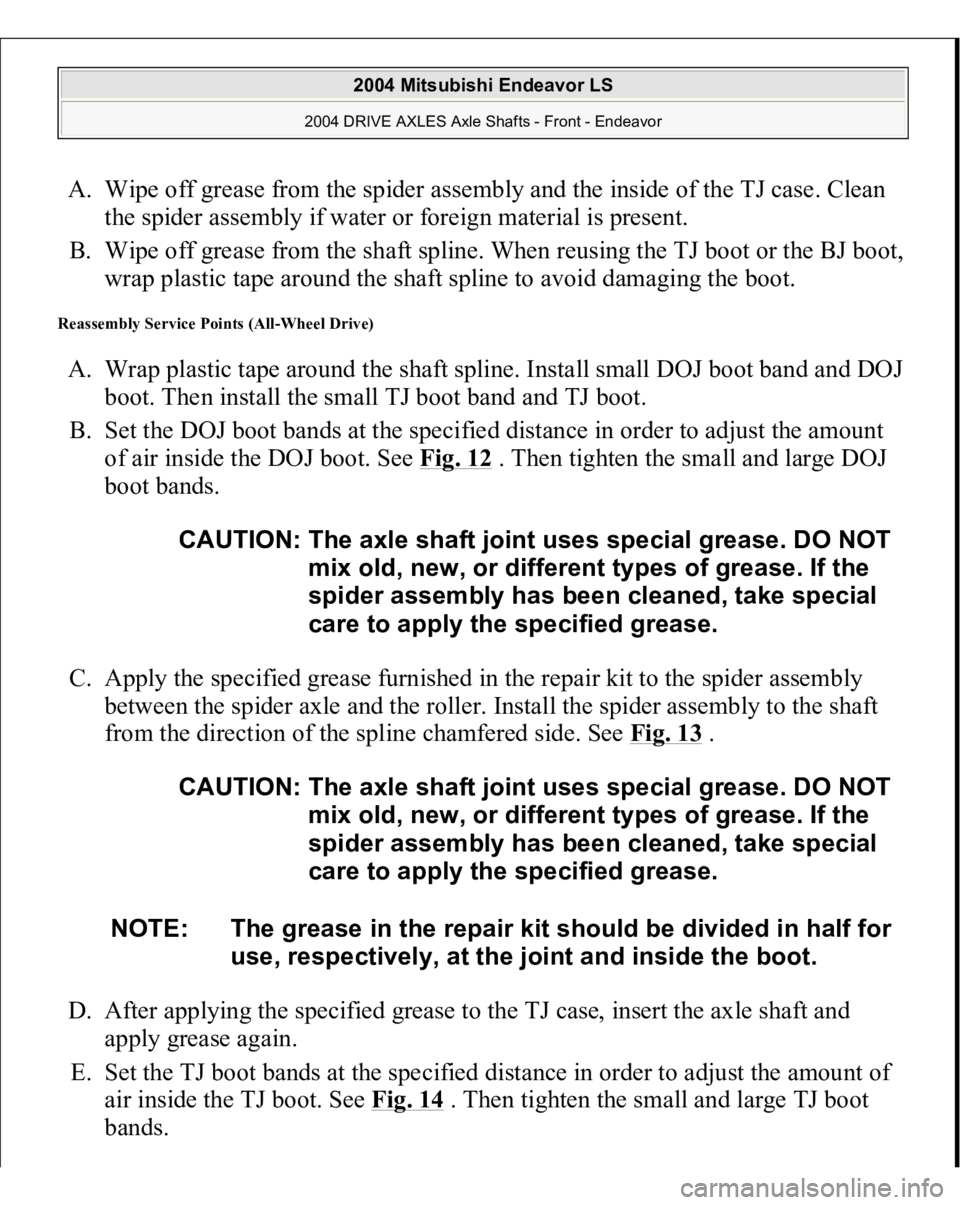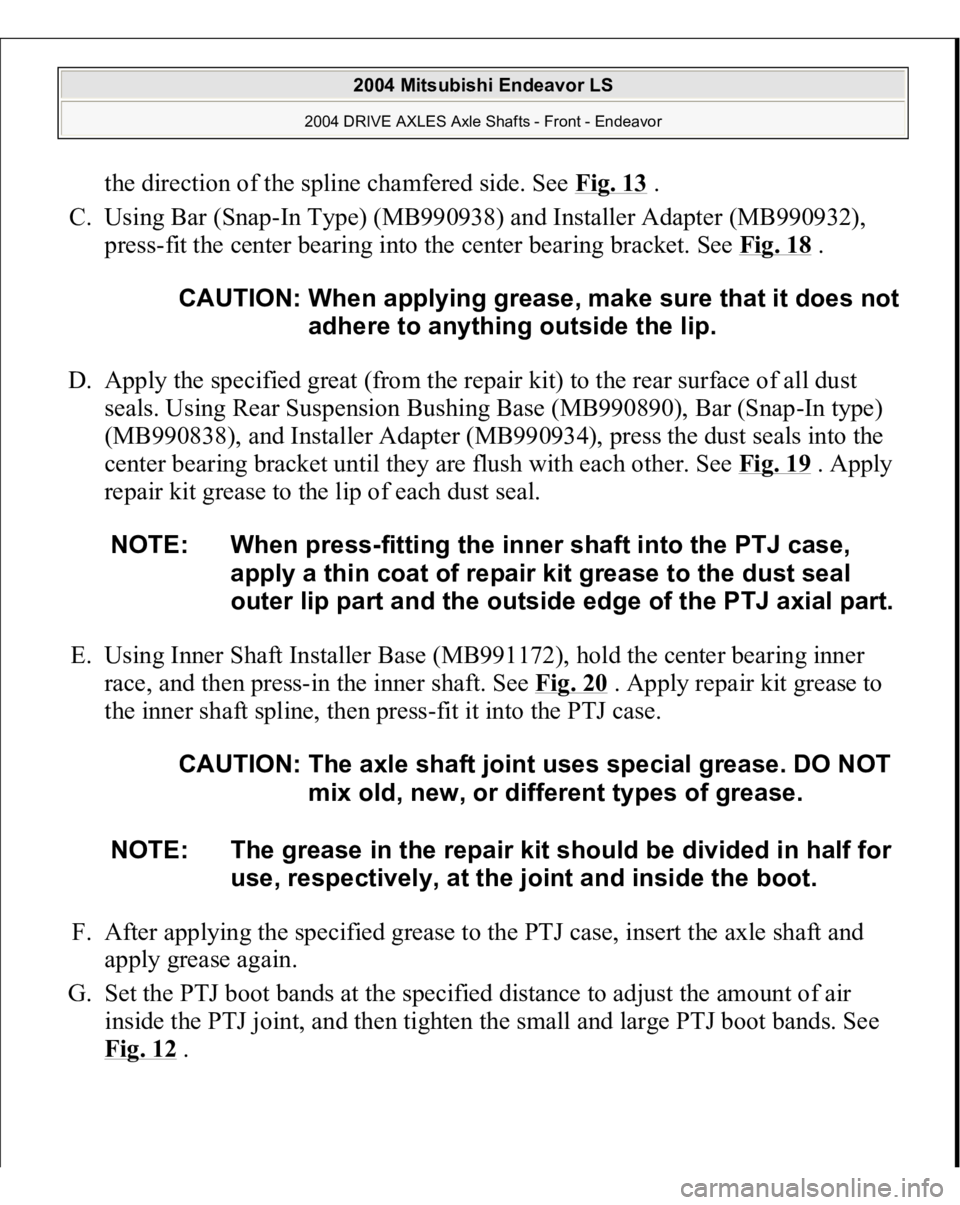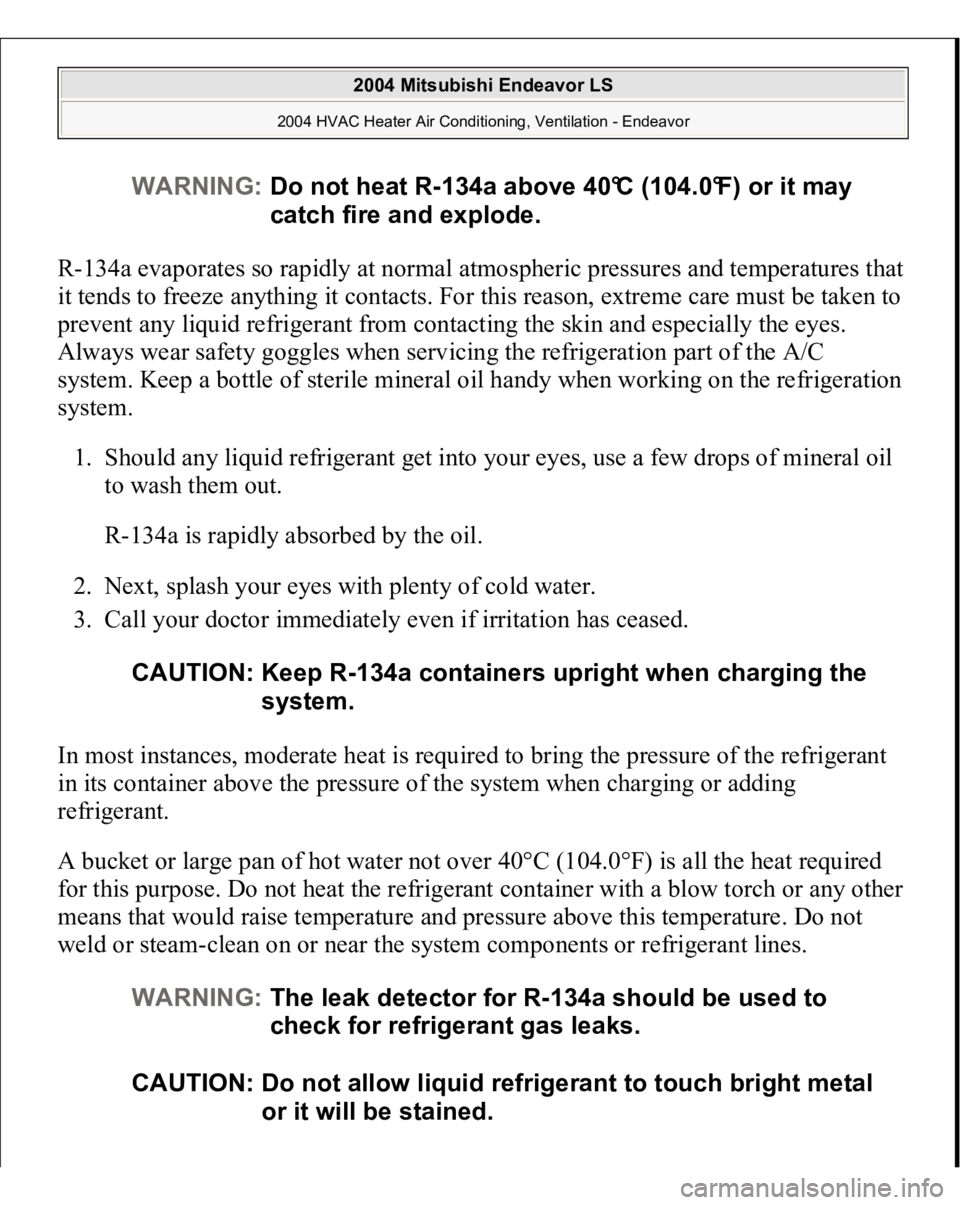Page 1774 of 3870

7. Does vehicle have an antenna which extend? If not eliminate this step.
If there is noise, the following causes can be considered.
8. If due to vehicle noise: It may not be possible to prevent noise if the signal is
weak.
9. If due to external noise: In almost all cases, prevention on the receiver side is
not possible. Weak signals especially are susceptible to interference.
If there is more noise than on radios in other vehicles, find out the noise condition
and the name and frequency of the receiving stations from the owner, and consult
with the radio manufacturer's service center. INSPECTION PROCEDURE 10: Sound mixed with Noise, Only at Night (AM). The following can be considered as possible causes of noise appearing only at
night.
1. It is significantly easier to receive long-distance signals at night. This means
that even stations that are received without a problem during the day may
experience problems at night. Remember that the weaker station is more
susceptible to interference. The appearance of a beat sound may occur in the
evening. A beat sound is created when two signals close in frequency interfere
with each other. A common sign of this type of interference is a repetitious
high-pitched sound that may over power the desired radio station. This sound is
generated not only by sound signals but electrical waves as well.
2. The changing system may also be a source of noise. When diagnosing radio
noise, do not over look the possibility of a problem with the vehicles generator. DIAGNOSIS
STEP 1. Check the vehicles lighting system.
Q: Does the noise disappear when the vehicles headlights are turned
"OFF"?
YES: Go to Ste
p 2.
2004 Mitsubishi Endeavor LS
2004 BODY & ACCESSORIES Radio With Tape Player & Cd Player - Endeavor
Page 1888 of 3870
Fig. 35: Pressing Inner Shaft Into PTJ Case
Courtesy of MITSUBISHI MOTOR SALES OF AMERICA.
>>F<< PTJ CASE INSTALLATION After applying the specified grease to the PTJ case, insert the drive shaft and apply
grease again.
Specified grease: Repair kit grease
Amount to use: 220 +/- 10 g (7.8 +/- 0.3 ounces)
CAUTION: The drive shaft joint use special grease. Do not mix
old and new or different types of grease.
NOTE: The grease in the repair kit should be divided in half for
use, respectively, at the joint and inside the boot.
2004 Mitsubishi Endeavor LS
2004 DRIVELINE/AXLES Front Axle Hub & Axle Shafts - Endeavor
Page 1897 of 3870
After applying the specified grease to the TJ case, insert the drive shaft and apply
grease again.
Specified grease: Repair kit grease
Amount to use: 125 +/- 10 g (4.4 +/- 0.3 ounces)
Fig. 43: Locating Grease Area On TJ Case
Courtesy of MITSUBISHI MOTOR SALES OF AMERICA.
CAUTION: The drive shaft joint use special grease. Do not mix
old and new or different types of grease.
NOTE: The grease in the repair kit should be divided in half for
use, respectively, at the joint and inside the boot.
2004 Mitsubishi Endeavor LS
2004 DRIVELINE/AXLES Front Axle Hub & Axle Shafts - Endeavor
Page 1926 of 3870

A. Wipe off grease from the spider assembly and the inside of the TJ case. Clean
the spider assembly if water or foreign material is present.
B. Wipe off grease from the shaft spline. When reusing the TJ boot or the BJ boot,
wrap plastic tape around the shaft spline to avoid damaging the boot. Reassembly Service Points (All-Wheel Drive) A. Wrap plastic tape around the shaft spline. Install small DOJ boot band and DOJ
boot. Then install the small TJ boot band and TJ boot.
B. Set the DOJ boot bands at the specified distance in order to adjust the amount
of air inside the DOJ boot. See Fig. 12
. Then tighten the small and large DOJ
boot bands.
C. Apply the specified grease furnished in the repair kit to the spider assembly
between the spider axle and the roller. Install the spider assembly to the shaft
from the direction of the spline chamfered side. See Fig. 13
.
D. After applying the specified grease to the TJ case, insert the axle shaft and
apply grease again.
E. Set the TJ boot bands at the specified distance in order to adjust the amount of
air inside the TJ boot. See Fig. 14
. Then tighten the small and large TJ boot
bands.
CAUTION: The axle shaft joint uses special grease. DO NOT
mix old, new, or different types of grease. If the
spider assembly has been cleaned, take special
care to apply the specified grease.
CAUTION: The axle shaft joint uses special grease. DO NOT
mix old, new, or different types of grease. If the
spider assembly has been cleaned, take special
care to apply the specified grease.
NOTE: The grease in the repair kit should be divided in half for
use, respectively, at the joint and inside the boot.
2004 Mitsubishi Endeavor LS
2004 DRIVE AXLES Axle Shafts - Front - Endeavor
Page 1934 of 3870

the direction of the spline chamfered side. See Fig. 13
.
C. Using Bar (Snap-In Type) (MB990938) and Installer Adapter (MB990932),
press-fit the center bearing into the center bearing bracket. See Fig. 18
.
D. Apply the specified great (from the repair kit) to the rear surface of all dust
seals. Using Rear Suspension Bushing Base (MB990890), Bar (Snap-In type)
(MB990838), and Installer Adapter (MB990934), press the dust seals into the
center bearing bracket until they are flush with each other. See Fig. 19 . Apply
repair kit grease to the lip of each dust seal.
E. Using Inner Shaft Installer Base (MB991172), hold the center bearing inner
race, and then press-in the inner shaft. See Fig. 20
. Apply repair kit grease to
the inner shaft spline, then press-fit it into the PTJ case.
F. After applying the specified grease to the PTJ case, insert the axle shaft and
apply grease again.
G. Set the PTJ boot bands at the specified distance to adjust the amount of air
inside the PTJ joint, and then tighten the small and large PTJ boot bands. See
Fi
g. 12
. CAUTION: When applying grease, make sure that it does not
adhere to anything outside the lip.
NOTE: When press-fitting the inner shaft into the PTJ case,
apply a thin coat of repair kit grease to the dust seal
outer lip part and the outside edge of the PTJ axial part.
CAUTION: The axle shaft joint uses special grease. DO NOT
mix old, new, or different types of grease.
NOTE: The grease in the repair kit should be divided in half for
use, respectively, at the joint and inside the boot.
2004 Mitsubishi Endeavor LS
2004 DRIVE AXLES Axle Shafts - Front - Endeavor
Page 1998 of 3870

R-134a evaporates so rapidly at normal atmospheric pressures and temperatures that
it tends to freeze anything it contacts. For this reason, extreme care must be taken to
prevent any liquid refrigerant from contacting the skin and especially the eyes.
Always wear safety goggles when servicing the refrigeration part of the A/C
system. Keep a bottle of sterile mineral oil handy when working on the refrigeration
system.
1. Should any liquid refrigerant get into your eyes, use a few drops of mineral oil
to wash them out.
R-134a is rapidly absorbed by the oil.
2. Next, splash your eyes with plenty of cold water.
3. Call your doctor immediately even if irritation has ceased.
In most instances, moderate heat is required to bring the pressure of the refrigerant
in its container above the pressure of the system when charging or adding
refrigerant.
A bucket or large pan of hot water not over 40°C (104.0°F) is all the heat required
for this purpose. Do not heat the refrigerant container with a blow torch or any other
means that would raise temperature and pressure above this temperature. Do not
weld or steam-clean on or near the system components or refrigerant lines.
WARNING:Do not heat R-134a above 40°C (104.0°F) or it may
catch fire and explode.
CAUTION: Keep R-134a containers upright when charging the
system.
WARNING:The leak detector for R-134a should be used to
check for refrigerant gas leaks.
CAUTION: Do not allow liquid refrigerant to touch bright metal
or it will be stained.
2004 Mitsubishi Endeavor LS
2004 HVAC Heater Air Conditioning, Ventilation - Endeavor
Page 2184 of 3870
Fig. 120: Locating Connector C
-106
Courtesy of MITSUBISHI MOTOR SALES OF AMERICA.
3. Measure the voltage between terminal 1 and ground.
The measured value should be approximately 12 volts (battery
positive voltage).
Q: Does the measured voltage correspond with this range?
YES:
Go to Step 5 .
NO:
Go to Ste
p 4.
2004 Mitsubishi Endeavor LS
2004 HVAC Heater Air Conditioning, Ventilation - Endeavor
Page 2227 of 3870
Fig. 158: Measuring Voltage Between Terminal No.10 And Ground
Courtesy of MITSUBISHI MOTOR SALES OF AMERICA.
The measured value should be approximately 12 volts (battery
positive voltage).
Q: Does the measured voltage correspond with this range?
YES:
Go to Step 18 .
NO:
Go to Ste
p 17.
2004 Mitsubishi Endeavor LS
2004 HVAC Heater Air Conditioning, Ventilation - Endeavor